Abstract: Objective To establish a three-dimensional visualization model of cerebellar deep nuclei, and to provide an anatomical basis for cerebellar functional imaging studies, functional correlation studies of electrical stimulation nuclei therapy and nuclei stereotaxic surgery. Methods The image data related to the cerebellar nuclei in the continuous thin section data and the high-resolution 3D MRI data of the specimens were selected, and the Amira 4.1 three-dimensional visualization software was used to accurately segment the deep cerebellar nuclei, and the obtained data were subjected to surface reconstruction and volume reconstruction. Results The reconstructed results clearly showed the adjoining relationship between the segmented deep cerebellar nuclei with pseudo-color and surrounding unsegmented true-color structures. Conclusion The results of 3D reconstruction can better show the position and shape of the deep cerebellar nuclei and the adjacent relationship with the surrounding cerebellar structures, which has important reference value for the functional imaging study of the deep cerebellar nuclei and the positioning of the nuclei in clinical treatment.
About the author: Fan Lingzhong (1982-), male (Han nationality), from Zaozhuang City, Shandong Province, Ph.D. Research direction: Tomographic anatomy
1. Introduction
In the study of cerebellar injury and its function, researchers found that the subregions of the cerebellar surface cortex and the deep nuclei have their own different functions, but due to the low resolution of early imaging equipment, the nuclei and cortex were rarely identified. Functional distinction [1,2]. How to accurately anatomically locate the functional subregions and deep nuclei of the cerebellar cortex has become a key issue for further in-depth study of cerebellar function. There are many anatomical atlases of the cerebellum at home and abroad. Due to their different naming methods, the structures referred to by various expressions are relatively vague, and their descriptions are mostly limited to gross anatomy, which cannot be applied to the study of functional imaging [3, 4]. The cerebellar atlas or cerebellar nuclei atlas based on histological sections are mostly ex vivo sections, and their display is inconsistent with the standard space used in functional imaging studies, and their application is also greatly limited. In the early days of the emergence of MRI technology, the cerebellar atlas based on MRI images was limited by layer thickness and low image resolution, and only distinguished the complex structure of the cerebellum in a limited number of major sections, including many cerebellar lobules, fissures and nuclei. Tuan et al. did not make a distinction, which also limited its application [5~9].
In order to meet the needs of functional imaging techniques such as positron emission tomography (PET), functional magnetic resonance imaging (fMRI), etc. to carry out research on cerebellar non-motor function and to accurately locate cerebellar injury sites, deep nuclei destruction surgery, electrical stimulation of cerebellar parietal nucleus treatment The need for studies of functional correlates of brain and cardiovascular disease [10,11]. In this study, the advanced 3D reconstruction software Amira4.1 was used for 3D visualization of the cross-sectional images with a slice thickness of 0.1 mm obtained by thin-slice section milling technology and the high-resolution MRI data collected by the 3DSPGR sequence. The reconstructed model can be very good. It shows the distribution law and morphology of deep cerebellar nuclei, and provides comprehensive anatomical data for cerebellar functional imaging research and clinical application[12~15].
2. Materials and methods
2.1 Image data acquisition
2.1.1 Specimen section data and MR image acquisition
2.1.1.1 Specimen selection 3 healthy adult male cadavers with formalin fixation for more than two years, normal development and no obvious organic lesions, were scanned by a 1.5T magnetic resonance scanner (Sonata SIEMENS, Germany) to exclude neurological diseases After traumatic brain injury, a head specimen was selected, and then continuous thin-layer cross-sectional milling was performed. The MRI scan parameters are: T1WI: TR=735.0ms, TE=7.7ms, SL=3mm, FOV=203mm×250mm; T2WI: TR=8330.0ms, TE=95.0ms, SL=3mm, FOV=201mm×230mm.
High-resolution 3.0T magnetic resonance scan (GE Company, USA), 3DFSPGR sequence MR image acquisition parameters: TR=6.5ms, TE=2.8ms, SL=1.4mm, no slice interval, FOV=240mm×240mm, NEX=3 , Matrix=256×256,.
2.1.1.2 Frozen milling For freezing, the head specimens were placed in a low-temperature freezer and frozen at -20 ℃, -30 ℃, and -40 ℃ for 2 days.
Embedding and fixing, using 3% gelatin solution with blue dye as the embedding agent, in a self-made embedding container with a marker rod, use a fixing frame to locate the specimen to ensure that the Yao's line of the specimen is perpendicular to the horizontal plane to ensure that the specimen is Milling parallel to the AC-PC line. Then add gelatin to the embedding box one by one, each layer of gelatin (20%) is added, and freeze for 24h.
CNC milling, in a low temperature laboratory at -15 °C, with the AC-PC line as the baseline, using an SKC500 CNC milling machine (Figure 1) for continuous milling to obtain thin cross-sections of the cerebellum (Figure 2).
For data acquisition, a Canon EOS 1Ds Mark II high-definition digital camera was used, and its own software was used to control the camera to collect images and obtain images.
3. Image processing
3.1 Image Processing Platform
Intel(R)core(TM)quad CPU, 2.40GHZ, 4G memory, ATI Radeon HD 3850 512M video memory, Windows XP sp2, Photoshop cs (Adobe; San Jose, CA), Amira (TGS company, France).
3.2 Image preprocessing
Convert the original RAW format image to uncompressed BMP format, and perform histogram equalization and normalization operations on the resulting image to achieve consistent brightness and contrast between images. And using the batch processing function in Adobe photoshop CS, the images related to the cerebellar nuclei were cropped in batches under the same range and size, and the sharpening degree was adjusted and converted into grayscale images for further processing.
3.3 3D visualization
3.3.1 Image registration
The registration of cross-sectional images is divided into two types: registration based on external control points and registration based on internal features of the image. Since the positioning rods are set during the production of thin-layer cerebellar slice images, a relatively simple registration based on external control points can be achieved. First, the image processing software Adobe photoshop CS was used to complete the preliminary registration of the landmark bars in adjacent slices by adjusting the transparency, and then the first layer image was selected as the benchmark, and the second layer image was registered with it. After obtaining the registration parameters, the second layer image is transformed, and the resulting image is output. The third-layer image is registered with the registered second-layer image, and the resulting image is output after transformation, and the rest of the images are deduced by analogy. MRI images can be automatically registered using the AffineRegistration module in Amira software.
3.3.2 Image segmentation
Accurate image segmentation is the basis of image 3D reconstruction. At present, image segmentation methods can be divided into two systems: computer automatic threshold segmentation and human-computer interactive image segmentation. This study applied a method combining manual segmentation with the semi-automatic interactive segmentation available in Amira software. Firstly, the method based on color component statistics is used to remove the original blue background; then Gaussian smoothing is used to remove the noise in the image, and a high-quality image is obtained. Using the PhotoshopCS software and the LabellingLabel Field (Fig. 4) module provided in the Amira software, manual and semi-automatic contouring methods and the liquid crystal pen display were used to segment the contours of the cerebellar structures, and the appearance of the cerebellar white matter nucleus was drawn, and the nuclei were drawn for each The structure performs RGB color assignment.
3.3.3 3D reconstruction and display
After the above processing, the data for surface rendering or volume rendering has been obtained, the cerebellum structure is established by contour lines, the surface model is established, and the three-dimensional model of the cerebellar nuclei is drawn by mixing the volume model and the surface model, providing multi-angle, multi-depth and arbitrary cross-section structures show.
Before reconstructing the 3D model from the sampled images, the translation or rotation in the AlignSlice module must be considered to align consecutive 2D images. Then, the surface reconstruction module in Amira software was used to obtain the original triangular surface, and the surface was post-processed to smooth the surface to obtain the reconstructed surface structure of the cerebellar nuclei.
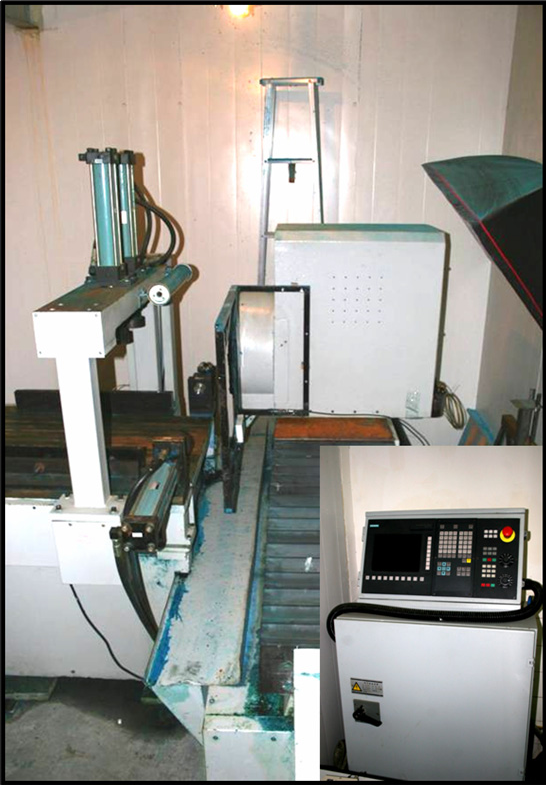
Figure 1 SKC500 CNC milling machine
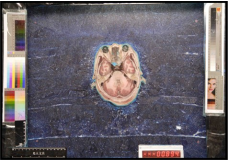
Fig. 2 Thin-section cross-sectional images
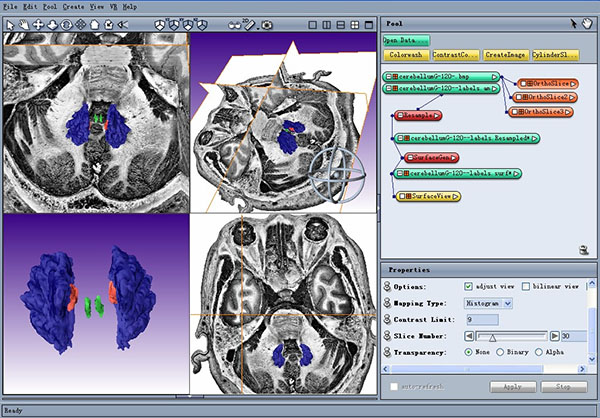
Figure 3 A. Section Data Processing Process
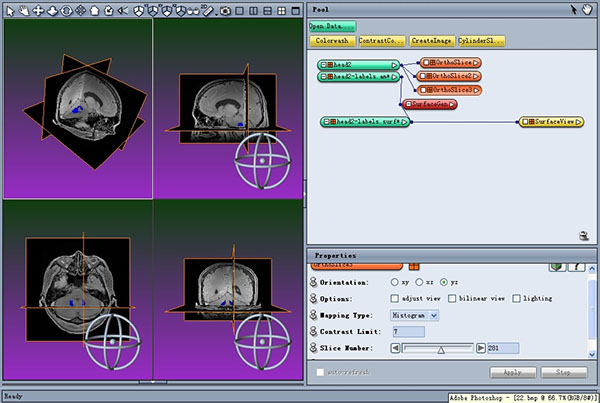
Figure 3 B. MRI data processing process
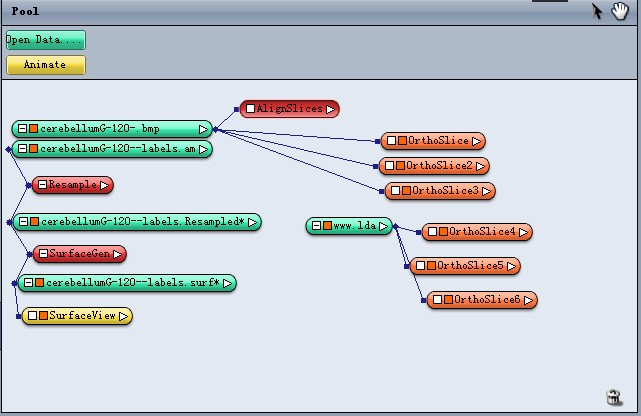
Figure 3 C. Amira handles the object pool
Amira software interface
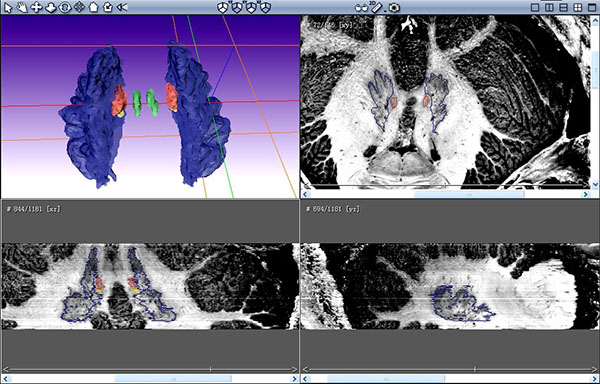
Figure 4 Label Field Module
4. Results
4.1. Specimen thin section data and nuclei display on MRI images
Dentate nucleus: In this case, about 145 consecutive thin slices were obtained in this case, and the cross-sectional morphology of the dentate nucleus was traced from the dorsal side to the ventral side. On cross-sectional and control T1MRI images, the dentate nucleus was the largest and most lateral in shape, resembling a folded pocket with an anterior-medial opening. The dentate nucleus appeared first on the continuous section, and it was used as a marker to identify the location of other cerebellar nuclei. The boundary between the medial and lateral sides of the posterior half was not clear, and it was connected to the medial interstellar nucleus in some layers. The plug-like nucleus is located inside the dentate nucleus, partially covering the hilum of the dentate nucleus, and is often difficult to distinguish from the dentate nucleus.
The parietal nucleus: the appearance of the parietal nucleus is second only to the dentate nucleus in successive cross-sections, and it occurs in about 12 slices. The parietal nucleus is the most medial cerebellar nucleus, immediately adjacent to the lateral aspect of the roof of the fourth ventricle and the medial aspect of the anterior part of the superior vermis, symmetrically distributed on both sides of the midline.
Interstitial nucleus: It is composed of spherical nucleus and plug nucleus, which appears in about 20-25 slices, but the two can only be distinguished in a few slices. Generally, the plug-like nucleus is located on the anterolateral side, and the spherical nucleus is located on the postero-medial side, and the spherical nucleus is composed of many small gray matter masses, so it is difficult to identify. Distinguished from differences in surrounding white matter. The results of this experiment can clearly observe the typical distribution position and morphology of plug-like nuclei.
4.2 3D reconstruction results of specimen section data

Figure 5A/B Top view, bottom view
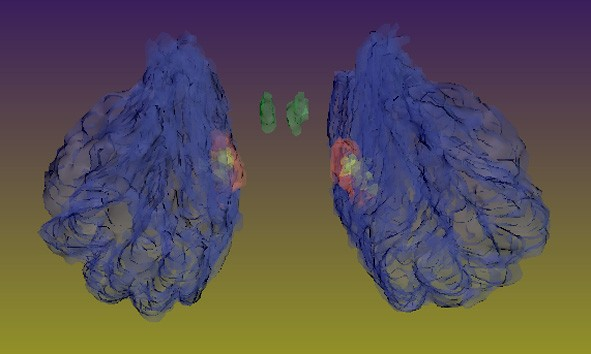
Figure 5C Translucent display
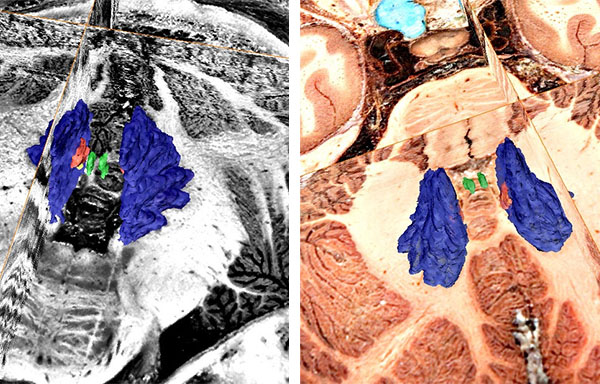
Figure 5D Overlay rendering (grayscale image) Figure 5E Overlay (RGB image)
Figure 5. 3D reconstruction results of specimen cross-section data (blue: dentate nucleus, green: parietal nucleus, red: plug-like nucleus, yellow: globular nucleus)

Figure 6A /B Front view/Back view

Figure 6 CD overlay renderings
Figure 6 3D reconstruction results of MRI images
(blue: dentate nucleus, green: parietal nucleus, red: cortical nucleus, yellow: globular nucleus)
5. Discussion
Amira4.1 is a set of object-oriented modular software system. Modules and data objects are its basic system components. The so-called modules are used to observe data objects or perform certain computing operations on these objects. Various components are represented by different icons in the object pool. Lines between icons indicate operational dependencies of different components. For example, a module is being applied to a specific data object. Specific module types are listed in a context-sensitive popup menu. Following the prompts in this menu, you can create corresponding modules to match existing data objects. Moreover, users can form a working network in the object pool with very little interaction. Various parameters of modules and data objects can be modified in the interactive area provided by Amira. Using Amira software, multi-directional display of two-dimensional physical slices can be realized, and slices can be observed in transverse, sagittal and coronal planes. By adjusting the number of slices, slice images on each section can be viewed. There are various display methods in Amira, Orthslice can realize the transverse sagittal crown display of general slices, StanderView can realize the simultaneous display of 3D images and transverse sagittal crowns, and ProjectionView can realize the projection display of images [13,16].
In this experiment, cryogenic milling was used, with continuous cross-section, no sawing loss, and a milling thickness of 0.1 mm. The detail and accuracy of reconstructed images [17, 18]. In addition, the high-resolution magnetic resonance FSPGR sequence images obtained by screening, the biggest difference between the specimen and the living body is that the T1 and T2 images can display similar structures, so the 3DT1 sequence images of the specimen can be obtained, and by increasing the number of excitations ( NEX=3), images with high signal-to-noise ratio were obtained [8, 19, 20], and the cerebellar nuclei were clearly displayed, which met the requirements of reconstruction. In the process of image segmentation, the manual segmentation of the LCD pen display improves the accuracy of structure recognition. The established three-dimensional visualization structure diagram of adult cerebellar nuclei can be displayed individually, in combination and as a whole. The visualization model of cerebellar nuclei can be cut from different directions and angles, and the adjacency of important anatomical structures of the cerebellum can be clearly displayed in true color. It can be observed continuously and dynamically, and local structures can be enlarged and displayed, and a three-dimensional coordinate system can be established with any point as the origin to observe the anatomical structure characteristics of the cerebellum in the transverse, coronal and sagittal planes. Shows the cerebellar surface fissure, the continuation relationship of the lobules. The combined method of surface rendering reconstruction and volume rendering reconstruction can clearly display the adjacent relationship between the segmented pseudo-colored cerebellar nucleus structures and the surrounding unsegmented true-color structures by adjusting the transparency and superposition of the image.
Early anatomical studies on the deep nuclei of the cerebellum mostly used tissue sectioning to observe the position of the nuclei. Although the morphology and positional relationship between four pairs of nuclei can be observed through tissue sections, because the sectioning is performed in vitro. Specimen preparation, and the choice of slice baselines is diverse.
Therefore, it cannot be well applied to the Talairach space commonly used in functional imaging [3~5]. With the development of modern imaging technology, many scholars have used high-resolution MR images to establish the atlas of the cerebellum and its nuclei. Since the deep nuclei of the cerebellum are in the conventional MRI scan sequence, only the dentate nucleus has a better T2-weighted image. display, so its application is also limited to a certain extent. Dimitrova et al. made up for the above shortcomings by using the probability map of nuclei established by multiple averaged T2MR images and tissue sections, but there are still drawbacks such as the reference standard is isolated sections, and MR images show low nuclei rate [8,9] , 20]. At present, there are few reports on the cross-sectional anatomy of the deep cerebellar nuclei, because except for the dentate nucleus, other cerebellar nuclei are small in size, and there are fewer layers in the previous thick slice specimens, which is difficult to observe. In this study, cryogenic CNC milling technology, magnetic resonance technology combined with computer three-dimensional reconstruction technology were used to obtain high-precision cerebellar cross-section and MRI images, and the position and shape of cerebellar nuclei on the cross-section and MRI were continuously observed. Appears at the outermost side, resembling a folded pocket-like structure that opens to the inside; the parietal nucleus is the innermost nucleus, adjacent to the outer side of the roof of the fourth ventricle and the inner side of the anterior part of the superior vermis, symmetrically distributed on both sides of the midline; The plug-like nucleus is located inside the dentate nucleus, and it is not easy to distinguish it. The nucleus partially covers the dentate nucleus; the globular nucleus is composed of multiple scattered gray matter masses, which elongate in an anterior-posterior direction and appear between the plug-like nucleus and the parietal nucleus. region, and then perform accurate manual segmentation based on this. In the study of deep cerebellar nuclei in functional imaging and stereotaxic surgery, the biggest difficulty is the positioning of nuclei in the image and the confirmation of the boundaries between nuclei. The image can accurately locate the position of the deep cerebellar nuclei and its morphological changes in continuous sections, which provides accurate information for the development of functional imaging of the deep cerebellar nuclei and the accurate positioning of various nuclei for neurophysiological stimulation. Anatomical basis.
references
[1] Desmond JE, Fiez JA(1998): Neuroimaging studies of the cerebellum: language, learning and memory. Trends Cogn. Sci. [J] 2: 355–362.
[2] Dimitrova A, De Greiff A, Schoch B, Gerwig M, Frings M, Gizewski ER, Timmann D(2006): Activation of cerebellar nuclei comparing finger, foot and tongue movements as revealed by fMRI. Brain Res. Bull. [J]71: 233-241.
[3] Afshar F, Watkins ES, Yap JC (1978): Stereotaxic atlas of the human brainstem and cerebellar nuclei. A variability study[M]. Raven Press, New York
[4] Liu Shuwei, sectional anatomy [M] Beijing: Higher Education Press 2006
[5] Talairach, P. Tournoux(1988): Talairach and P. Tournoux, Co-planar Stereotaxic Atlas of the Human Brain[M], Georg Thieme Verlag, New York
[6] Schmahmann JD,Doyon J, McDonald D,Holmes C, Lavoie K,Hurwitz A.S, Kabani N, Toga AW, EvansA, PetridesM.(1999): Three-dimensional MRI atlas of the human cerebellum in proportional stereotaxic space. Neuroimage [J]10:233–260.
[7] Jörn Diedrichsen(2006): A spatially unbiased atlas template of the human cerebellum. Neuroimage[J] 33(1):127-38.
[8] Dimitrova A,Weber J, Redies C, Kindsvater K, Maschke M, Kolb F.P, Forsting M., Diener H.C and Timmann D(2002): MRI atlas of the human cerebellar nuclei. NeuroImage [J]17:240–255.
[9] Dimitrova A, Zeljko D, Schwarze F, Maschke M, Gerwig M, Frings M, Beck A, Aurich V, Forsting M , Timmann D(2006): Probabilistic 3D MRI atlas of the human cerebellar nuclei. NeuroImage[J] 30:12-25.
[10] Dong Weiwei. Electrical stimulation of cerebellar parietal nucleus and central nervous system-derived neuroprotection[J]. Chinese Engineering Science,2001,3(11):32—38.
[11] Haines DE, Dietrichs E, Mihailoff GA, et al. The cerebellar-hypothalamic axis: basic circuits and clinical observations.Inter Rev Neurobiol[J], 1997, 41:83-11.
[12] Zhang Shaoxiang, Liu Zhengjin, Tan Liwen, et al 1 The first case of Chinese women's digital visual human body data set and visualization research 1 Journal of the Third Military Medical University,2003 ,25(5) :394 - 396
[13]Gao Hongjian; Wu Shuicai; Ren Xinxin, et al. Using Amira for 3D reconstruction of the liver and its duct system. Beijing Biomedical Engineering
[J] 2006; 25(5): 534-537
[14]Feng Qianjin; Liu Yang; Chen Wufan. Construction of a 3D visualization system for medical images. Chinese Journal of Medical Physics[J] 2006; 23(4): 244-246
[15] Li Wandong; Xu Huimian; Ling Guanglie, et al. 3D Reconstruction of Human Abdominal Organs with Chinese Digital Visualization. Journal of China Medical University
[J] 2006; 35(5): 484-486
[16] Amira 4.11 Manual (PDF) . 2003. MERCURY
[17] Spitzer V M, Whitlock D G. The visible human dataset: The anatomical platform for human simulation[J].
Anatomical Record 1998 ,253(2)49-57
[18]Zhong Shizhen, editor-in-chief, 2004 Digital and Digital Anatomy [M], Shandong Science and Technology Press
[19] Sean CL and Marco C.Visualization of the deep cerebellar nuclei using quantitative T1 and ρ magnetic resonance imaging at 3 Tesla. NeuroImage [J]2007,37(4) : 1260-1266.
[20] Toga A.W, Goldkorn A, Ambach, K, et al. Postmortem cryosectioning as an anatomic reference for human brain mapping[J].Comp.Med.Image & Graphics [J]1997; 21(2): 131-141.
Note: The source of the article is from the Internet. If there is any infringement, please contact to delete it! thanks



























 Home
Home Telephone
Telephone Message
Message







